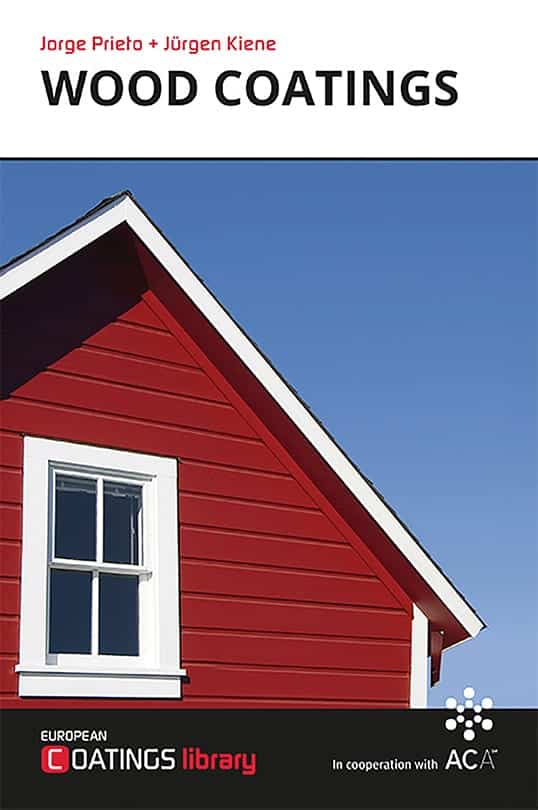Wood Coatings: Chemistry and Practice is a comprehensive book on all aspects of wood coatings. It provides a holistic perspective that includes a brief history and development, basic market metrics, trends and needs (including social trends driving needs for coatings), introductory science of wood materials, wood coating types (including binder chemistry and formulation ingredients), pretreatments, application processes, drying conditions, wood discoloration and deterioration, and VOC emission concerns.
The book is particularly focused on the European market and most specifically Germany, presumably because of the authors’ familiarity with this region. For example, many of the German wood and wood coatings market trends and needs are described. Typically, standard test procedures are described, and their associated DIN standards are referenced. German regulations also are noted. Nonetheless, the discussion of wood coatings is excellent and the reader, regardless of geographic region, can understand and apply much of the information presented, especially the technology aspects.
Introductory Chapters
The introductory chapter, although not lengthy, provides a basic background and historical perspective of wood coating applications, with a major focus on furniture finishes. For example, it cites market metrics for global and European furniture production. It also provides general information on current wood coating market needs and trends. The authors briefly detail the contribution of coating process cost to the total manufacturing cost of furniture. For market trends, the authors highlight VOC reductions and residual emissions from coated end products (with a later chapter focused on this subject). For exterior coatings, the authors discuss the desire for longer warranty periods for coatings and end products, which, of course, is highly impacted by coating application, quality, and performance. This chapter sets the stage for the rest of the book in connecting wood coating requirements, types, and properties, how they have been used historically, and how they are evolving to meet market and societal needs.
The second chapter focuses on the properties of wood—describing the microscopic structure, morphology, and chemical composition within the various internal wood components. A connection also is provided between these basic material characteristics and wood properties such as hardness and degradation. A variety of wood species are described, especially those that are most commonly used. This leads into a discussion of related wood properties, such as water absorption and hardness, which in turn explains the use of various woods in applications, such as wood paneling, flooring, and furniture. The chapter provides an explanation and appreciation for wood characteristics that impact coating selection and performance, as well as end use and service life.
Coatings for Wood and Wood-based Materials

Wood Coatings: Chemistry and Practice authored by Jorge Prieto and Jürgen Kiene 394 pages, hardcover, 7” x 10”, English ISBN-13: 978-3866306080 ISBN-10: 3866306083
Publisher: Vincentz Network
www.american-coatings-bookshop.com
The chapter on wood coatings is the most detailed and extensive (250 pages), with a major focus on industrial coatings (i.e., generally, factory applied during manufacturing). This chapter is separated into two major sections on interior coatings and exterior coatings. Both of these major sections have subsections on the various types and binder chemistries used in the respective applications. These subsections describe the binder chemistry types (including chemical structure), formulation ingredients (pigments, extenders, additives, and solvents) and example formulations, specific applications (e.g., furniture, joinery, etc.), along with the strengths and weaknesses of the various coating types for these applications. All of the chapters contain ample references, with the wood coatings chapter noting an impressive 496 references for the reader to explore further details.
Pretreatment and Application
Chapter 4 discusses pretreatment of wood (but generally not chemical pretreatments such as pressure/chemical treatments). It is a short chapter that focuses mainly on mechanical treatment processes of grinding and smoothing. There is a short section that discusses the importance of proper drying, but the authors admit this topic is not thoroughly addressed within this book. They also provide a brief description on the importance and processes to remove resin from fresh wood, but again this is not highly detailed. The chapter does not provide many specifics but gives the reader an introductory understanding and appreciation for wood preparation processes prior to end product construction, assembly, and coating.
There are a variety of application processes used for coating wood, including dipping. They include flow coating, tumbling, spraying (various spray methods), curtain coating, roller, and vacuum coating. These processes are described in fairly specific detail, which includes procedures as well as where they are used, as well as advantages and disadvantages of each. Schematic diagrams are provided for most of the related application equipment and process lines. Important information such as typical transfer efficiency of the various methods is provided. This chapter gives the reader an appreciation of how various coatings are used and applied to wood products, as well as some of the associated required coating parameters.
Drying and Curing Processes
Chapter 7 describes drying and curing processes. It covers the parameters that influence drying and curing, including contributions from the surrounding environment, the coating film, and the wood substrate. Also included is an extensive table describing the challenges in coating wood and in applying waterborne coatings to wood. Subsections describe air drying, convection, infrared heat, microwave, ultraviolet (UV) and electron beam (EB) drying, and curing. Specific descriptions and parameters are provided for each, as well as related advantages and disadvantages. Schematic diagrams are provided for most of the procedures.
Discolouring of Wood
The next chapter focuses on “Discolouring of Wood,” which generally refers to deterioration and degradation. Of course, a main reason for the use of wood in finish products is its attractive appearance (in addition to its structural properties). That is why this chapter focuses on appearance and discoloring. Factors influencing performance are discussed (e.g., dirt, chemicals, light, and heat). The authors relate wood composition (the focus of Chapter 2) to degradation causes and mechanisms. This leads to an explanation of the importance of and reasons why coatings can be used to delay or avoid discoloration and degradation. Seventeen references are provided to support the discussion and obtain additional related information.
VOC Emissions
The chapter entitled “VOC Emissions” discusses emissions from the painting process, and residual emissions after drying and curing of wood coatings; for example, after a piece of furniture is purchased and then resides in its place of use, with surrounding people exposed to potential emissions. The chapter provides some recent history and evolution of VOC concerns, regulations, and definitions (which are highlighted and can vary). This leads to a discussion on the resulting requirements for and response from coating manufacturers and applicators. A specific section is provided on special requirements for coating wood-based products, with detailed discussion and decision flow diagrams to address solvent regulation reductions for wood coatings. The authors also cover solvent reduction plans and schedules with several variations and alternatives. The discussion on emissions from production concludes with two examples of good coating application practice for (1) furniture manufacturing and (2) wooden stair manufacturing. The examples provide quantitative metrics and steps to meet emission reduction requirements. The second major section in this chapter addresses residual emissions after drying, which includes emissions from the paint, but also potential emissions from the wooden product, such as formaldehyde. Again, this chapter focuses on German regulations and references, but the concepts apply globally. The authors provide a description of the cause and effects of these emissions and then detail the contributing effects of coatings. This chapter is reasonably lengthy (25 pages), with considerable detail, and 41 references for further information.
Coatings Trends
The final chapter of the book briefly discusses trends for wood coatings. Included are globalization of markets (including supply of raw materials), trends within individual coating technologies (including influence of desired increase of coating application/line speeds), appearance (trending towards wide range of desired gloss from very high to extremely low gloss), sustainability (including lifestyle and health concerns), more highly functional coatings (scratch resistance, anti-bacterial, dust repellent, anti-slip, self-healing, haptic surfaces), and trends in application desires and technology. Although this final chapter is short, it provides a glimpse into trends and desires that can drive coatings technology and industry.
In summary, Wood Coatings is a good reference. It has two major contributing strengths. First, it presents a full spectrum of topics related to wood coatings, which includes market trends, wood science, coating technologies, applications and drying, degradation, and regulations. Although some of the chapters are short, they provide enough useful information and references for the reader to have a good impression of the salient points, and ample references to obtain additional information. The second strength is the level of detail provided in the coatings for wood chapter. This is quite extensive and specific, with a thorough presentation on related wood coating chemistry, formulation, and performance. A good reference book for those interested in wood coatings.
—Submitted by Dr. Charles R. Hegedus, CoatingsTech Technical Editor
CoatingsTech | Vol. 15, No. 7 | July 2018
